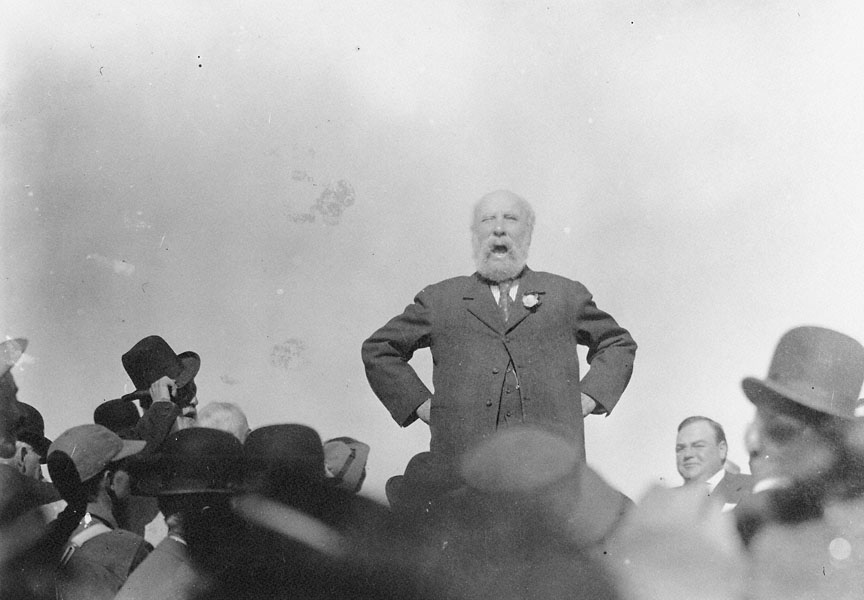- Catalog No. —
- OrHi 12122
- Date —
- October 5, 1911
- Era —
- 1881-1920 (Industrialization and Progressive Reform)
- Themes —
- Trade, Business, Industry, and the Economy, Transportation and Communication
- Credits —
- Oregon Historical Society
- Regions —
- Central
- Author —
- Unknown
James J. Hill in Bend, 1911
This photograph of James J. Hill speaking in Bend was taken moments after he hammered the golden spike to complete the Oregon Trunk Railway on October 5, 1911. During his speech, Hill credited his decision to build a railroad into central Oregon to a conversation that he had with William Hanley, a major landholder and cattle baron of eastern Oregon. Hill encouraged people at the ceremony to focus their efforts at cultivating agricultural products for consumption by urbanites. According to Hill, “There is no reason why Central Oregon should not produce enormous wealth. We have a good deal of faith in it. If we did not have we would not have come here.”
Born in Rockwood, Ontario in 1838, Hill attended both public and private schools. When his father died in 1852, he quit school for a job in a general store. In 1856 Hill left home, intending to travel to Asia, but finding the trip prohibitively expensive, only traveled as far as Minnesota, then settled in St. Paul. There he landed a series of jobs with wholesale distribution companies. In 1865, Hill went into business for himself as an independent transportation agent. In 1870, he and his partners established the Red River Transportation Company, opening steam boat travel between St. Paul and Winnipeg. Eight years later Hill secured his first railroad, the St. Paul and Pacific, later the St. Paul, Minneapolis and Manitoba.
In 1890, Hill and his partners decided to extend their westering line to the Pacific. They set up a new corporation, calling it the Great Northern Railway, which reached Puget Sound three years later. After competing with E. H. Harriman’s Union Pacific for control of the Chicago, Burlington and Quincy, Hill and his partner J. P. Morgan called a truce with Harriman and created the Northern Securities in 1901, uniting the Great Northern, Northern Pacific, and Chicago, Burlington and Quincy railways. The company was large and, with two transcontinental lines to its credit, monopolistic. The government dismantled it in 1904.
Toward the end of his career, Hill built the Oregon Trunk Railway to connect Bend with his line on the north bank of the Columbia. To make the line profitable, he promoted the Bend area as an agricultural garden spot. Some settlers were disappointed, finding the altitude and aridity of the region a hindrance to agriculture. Similar sentiments among settlers on the Northern Plains earned Hill a dubious legacy in the form of this schoolyard rhyme: “Twixt Hill and Hell there’s just one letter. Were Hill in Hell we’d feel much better.” More flattering tributes followed Hill’s death in St. Paul in 1916. Amtrak’s daily service between Seattle, Portland, and Chicago is named the “Empire Builder,” after Hill.
Further Reading:
Martin, Albro. James J. Hill and the Opening of the Northwest. St. Paul, Minn., 1991.
Hidy, Ralph W., Muriel E. Hidy, Roy V. Scott, and Don L. Hofsommer. The Great Northern Railway: A History. Minneapolis, Minn., 2004.
Malone, Michael. James J. Hill: Empire Builder of the Northwest. Norman, Okla., 1996.
Written by Joshua Binus, © Oregon Historical Society, 2004.
Related Historical Records
-
Oregon and California Railroad
The Oregon and California Railroad (O&C) was the first railroad to connect Oregon with California. Construction of the line began in Portland during the spring of 1868. Under …

-
Railroads into Central Oregon
At the turn of the century, when local railroad service had become an established part of the economics and culture of most rural communities in the United States, …
